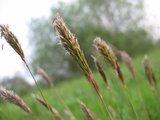3408 Anthoxanthum L.
- L., Sp. Pl.: 28 (1753).
Notes: We consider Anthoxanthum and Hierochloë two genera (see notes to Hierochloë below).
Anthoxanthum odoratum is mainly tetraploid and A. nipponicum (= A. alpinum) mainly diploid, see the thorough study of I. Hedberg (1961, 1964, 1967, 1969, 1970) and, e.g., Jones (1964), Jones and Melderis (1964), Tateoka (1966), Aaberge (1966), Engelskjøn (1979), and Felber (1986). Felber (1986, 1987) regarded them as two well distinguished species. Many authors (see Conert 1998) assume tetraploid A. odoratum to be at least partly an allotetraploid with A. nipponicum as one of its diploid parents. This European view contrasts with the North American one, where Allred and Barkworth (2007) included A. nipponicum (as A. alpinum) in A.odoratum and stated that "the two ploidy levels can be distinguished only through cytological examination". This is contrary to European experience where the two taxa in most cases are morphologically recognizable at a glance. In northern regions, A. odoratum s. str. is distinguished vs. A. nipponicum by: panicle branches and mostly also lemmas hairy vs. glabrous; lemmas dull and rough vs. shiny and smooth, golden brown vs. deep bronze to purplish; and awns short and slightly exserted vs. longly exserted. Jones and Melderis (1964) listed ca. 10 characters separating the two taxa. Triploids (hybrids) occur but are rare and sterile (e.g., I. Hedberg 1967). We accept two species due to morphological consistency and discontinuity, ploidy difference (predominantly), significant range overlap without intermediacy except for sterile triploid hybrids, and the suggested allopolyploid origin of A. odoratum.
